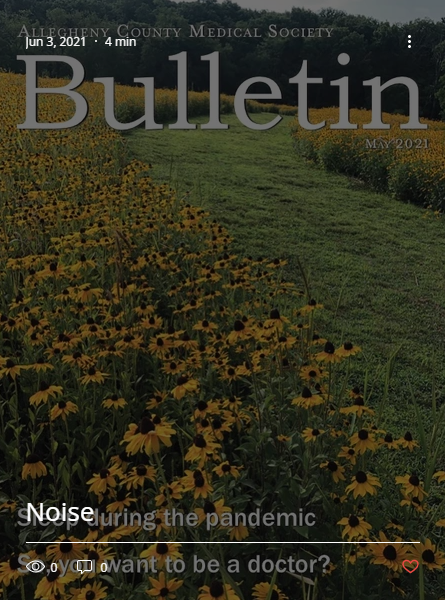
“Oh, the Noise! Oh, the Noise! Noise! Noise! Noise!” – Dr. Seuss, “How the Grinch Stole Christmas,” 1957
“Before the Industrial Revolution, the principle sources of noise were thunder, church bells, and cannon fire.”
– New York Times, Jan. 1, 2021
We are surrounded by noise. Noise can rob us of sleep; it can hinder our ability to concentrate; it also can affect our hearing. I first became aware of noise-induced hearing loss when I was in the Air Force. One day, one of the enlisted men who was assigned to the base carpentry shop came to see me because of hearing loss. I sent him to an audiologist for testing, which confirmed noise-induced nerve deafness. One of my hobbies is woodworking, and I spent many hours in that same carpentry shop myself. I had noted how loud the noise was, particularly when certain of the woodworking machines were being used. I made a call to the Occupational Safety department on the base and asked them to do a noise survey of the shop. Not surprisingly, they found hazardous levels of noise. In particular, the thickness planer was the biggest offender. The noise produced from that machine alone was similar to that produced by a jet engine! They recommended that all personnel using the carpentry shop (staff and craftsmen) use ear protection. They also mandated installation of sound-deadening acoustic baffles over the noisiest machines. The young airman who was my patient would be eligible for lifetime service-connected disability payments following discharge.
This incident prompted me to continue using ear protection in my own workshop. I also began using ear plugs whenever I flew on an airplane after noting how loud the cabin noise was, especially on take-offs and landings. Airbuses and Boeing 757’s were the biggest offenders in my opinion. Interestingly, flight attendants report an increased incidence of hearing loss over time.
In spring 1995, I worked as staff at a council-wide jamboree conducted by the Boy Scouts. The concluding activity was a concert by a local Country and Western band. I was recruited to use my carpentry skills in construction of the stage. I also volunteered to work as a member of the stage crew, when one of the other leaders became ill and had to leave. During the concert, I was behind the stage and noted to my colleagues how loud the band was. Even though I was never in front of the multiple amps on the stage, I went to bed that night with tinnitus. In the morning, the tinnitus was gone, or so I thought.
A month later, I was at scout camp. One of the features I love about scout camp is being able to appreciate the beauty of God’s creation in a wilderness setting. In particular, this is noticeable at night, where the sounds of the daily hub-bub are replaced by a heavenly quiet, punctuated by occasional sounds by the nocturnal creatures – the chirping of crickets, the hoot of an owl. It was in that environment that I awoke early one morning before everyone else and was aware of a soft rumbling sound. At first, I thought someone was listening to a portable radio. However, as I became more awake, I realized the sound was in my own ears! And, more disturbing, the rumbling sound was accompanied by a high-pitched hiss.
Once I was back home from camp, I made an appointment to see neuro-otologist Douglas Chen, who sent me for testing. My audiology test showed “classic” noise-induced nerve deafness. Although I didn’t perceive any loss of hearing, I asked Dr. Chen about hearing aids and was told that they were not helpful for this type of hearing loss, and, in fact would only amplify any ambient noise. He did recommend that I start using ear protection whenever I was in a noisy environment. So, in addition to using ear protection in my shop and on an airplane, I began using ear plugs when playing in my two concert bands (where I sat in front of a row of trumpets for over an hour at each rehearsal) as well as when I attended wedding and bar/bat-mitzvah receptions, where the music was always too loud. Regarding band, one positive result of using ear plugs is that I can now hear myself playing and can quickly adjust my flute when I go out of tune.
We live in a noisy world. What prompted me to write this editorial was the daily cacophony produced by many lawn service people using leaf blowers cleaning the yards in my heavily treed neighborhood. Interestingly, few, if any, of the operators of this equipment use ear protection. It is impossible to take a nap (some of the services work seven days a week). In the spring and summer, the noise of the leaf blowers is replaced by that of lawnmowers. Fortunately, our winters are not as severe as those where I grew up in upstate New York, and we’re not plagued by the sounds of snow blowers.
In my daily walks, I frequently hear loud music coming from cars that pass me. It’s one thing to hear the music in the summertime when car windows are often down. However, whenever I hear the music coming from a car with the windows up, I think of the amount of hearing loss the driver (usually young) will have in a decade.
Noise pollution, like air pollution and water pollution poses definite health hazards. It is incumbent on all of us to not only protect our own ears, but also to tell our children about the hazards of noise.

